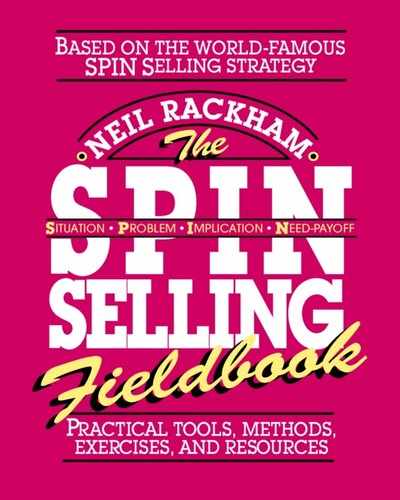Book Description
Put into practice today's winning strategy for achieving success in high-end sales!
The SPIN Selling Fieldbook is your guide to the method that has revolutionized big-ticket sales in the United States and globally. It's the method being used by one-half of all Fortune 500 companies to train their sales forces, and here's the interactive, hands-on field book that provides the practical tools you need to put this revolutionary method into actionimmediately. The SPIN Selling Fieldbook includes:
- Individual diagnostic exercises
- Illustrative case studies from leading companies
- Practical planning suggestions
- Provocative questionnaires
- Practice sessions to prepare you for dealing with challenging selling situations
Written by the pioneering author of the original bestseller, SPIN Selling, this book is aimed at making implementation easy for companies that have not yet established SPIN techniques. It will also enable companies that are already using the method to reinforce SPIN methods in the field and in coaching sessions.
Table of Contents
- Cover
- Title Page
- Copyright Page
- Contents
- Introduction
- 1 Using the SPIN® Fieldbook
- 2 Instant SPIN® Model
- 3 Check It Out!
- 4 Four Stages of a Sales Call
- 5 Putting SPIN® to Work
- 6 Focusing on Buyer Needs
- 7 Situation Questions
- 8 Problem Questions
- 9 Implication Questions
- Overview
- Using Implication Questions Effectively
- What Goes into Good Implication Questions?
- You Already Know How to Use Implication Questions
- How Implication Questions Work
- Did You Notice?
- Planning Implication Questions
- Four Steps for Planning Effective Implication Questions
- How to Phrase Effective Implication Questions
- Implication Questions and the Complex Sale
- When to Ask Implication Questions and When to Avoid Them
- Low-Risk Implication Questions
- High-Risk Implication Questions
- Beyond the Basics—Implication Questions
- 10 Need-payoff Questions
- Overview
- Using Need-payoff Questions Effectively
- Try Out the ICE Model
- How NOT to Ask Need-payoff Questions
- Need-payoff Questions and the Complex Sale
- Need-payoff Questions Reduce Objections
- When to Ask Need-payoff Questions and When to Avoid Them
- How to Phrase Effective Need-payoff Questions
- Beyond the Basics—Need-payoff Questions
- 11 Demonstrating Capability
- Overview
- Features, Advantages, and Benefits
- Advantages
- Defining Benefits
- True Benefits
- How Features, Advantages, and Benefits Affect Buyers
- Preventing Objections vs. Handling Objections
- Handling Value Objections
- Tipping the Value Equation toward a Buy Decision
- Benefits Meet Explicit Needs
- Stating Benefits
- Beyond the Basics—Demonstrating Capability
- Strategies for Handling Capability/Can’t Objections
- Strategies for Handling Capability/Can Objections
- Launching New Products or Services
- 12 Sharpening Your Skills
- 13 Getting Help and Helping Others
- SPIN® Forms
- Index
- About the Author
